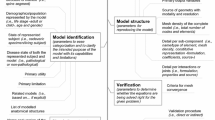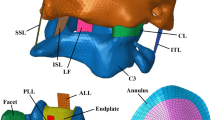Abstract
A Finite Element Model (FEM) of the young adult human cervical spine has been developed as a first step in studying the process of spondylotic degeneration. The model was developed using normal geometry and material properties for the lower cervical spine. The model used a three-zone composite disc annulus to reflect the different material properties of the anterior, posterior, and lateral regions of the annulus. Nonlinear ligaments were implemented with a toe region to help the model achieve greater flexibility at low loads. The model was validated against experimental data for normal, nondegenerated cervical spines tested in flexion and extension, right and left lateral bending, and right and left axial rotation at loads of 0.33, 0.5, 1.0, 1.5, and 2.0 Nm. The model was within in vitro experimental standard deviation corridors 100% of the load range for right and left lateral bending. The model was within 80% of the load response corridors for extension and flexion with a deviation <0.3° from the SD corridors. For axial rotation, the model was within 70% of the SD corridors for left axial rotation within 83% of right axial rotation responses. The deviation from SD corridors for axial rotation was generally <0.2°.







Similar content being viewed by others
References
Acaroglu E. R., Iatridis J. C., Setton L. A., Foster R. J., Vow V. C., Weidenbaum M., 1995. Degeneration and aging affect the tensile behavior of human lumbar anulus fibrosus. Spine 20 (24), 2690–2701
Bozic K. J., Keyak J. H., Skinner H. B., Bueff H. U., Bradford D. S., 1994. Three-dimensional finite element modeling of a cervical vertebra: investigation of burst fracture mechanism. J. Spinal Disord. 7, 102–110
Brolin K., Halldin P., 2004. Development of a finite element model of the upper cervical spine and a parameter study of ligament characteristics. Spine 29(4), 376–385
Chazal J., Tanguy A., Bourges G., Gaurel G., Escande G., Guillot M., Vanneuville G., 1985. Biomechanical properties of spinal ligaments and a histological sudy of the supraspinal ligament in traction. J. Biomech. 18(3), 167–176
Clausen, J. D. Experimental and theoretical investigation of cervical spine biomechanics: effects of injury and stabilization. PhD thesis, University of Iowa, Iowa City
Clausen, J. D., Goel, V. K., Traynelis, V. C., Scifert, J., 1997. Uncinate processes and Luschka joints influence the biomechanics of the cervical spine: quantification using a finite element model of the C5–C6 segment. J. Orthop. Res., 15(7), 342–347
Clausen, J. D., V. K. Goel, V. C. Traynelis, and D. G. Wilder. Cervical spine biomechanical investigation using an experimentally validated FE model of C5–C6 motion segment. In: Proceedings of the 42nd Annual Meeting of the Orthopaedic Research Society. Atlanta, GA, 1996
Connell, M. D., Wiesel S. W., 1992. Natural history and pathogenesis of cervical disk disease. Orthop. Clin. North Am. 23, 369–380
Cusick J. F., 1991. Pathophysiology and treatment of cervical spondylotic myelopathy. In: Black, P. (Ed.), Clinical Neurosurgery. Williams & Wilkins, Baltimore, MD, pp. 661–681
Cusick, J. Pathophysiology of cervical spondylotic myelopathy. In: Frontiers in Head and Neck Trauma, edited by N. Yoganandan, F. A. Pintar, S. J. Larson, A. Sances, Jr. The Netherlands: IOS Press, 1998 pp. 690–701
Dauvilliers, F., F. Bendjellel, M. Weiss, F. Lavaste, and C. Tarriere. Development of a finite element model of the neck. In: 38th Stapp Car Crash Conference, 77–91. 1994A13, 1994
Ebara, S., Iatridis J. C., Setton L. A., Foster R. J., Mow V. C., Weidenbaum M., 1996. Tensile properties of nondegenerate human lumbar anulus fibrosus. Spine 21(4), 452–461
Friedenberg, Z. B., Edeiken J., Spencer N., Tolentino S. C., 1959. Degenerative changes in the cervical spine. J. Bone Joint. Surg. 41A(1), 61–71
Galante, J. O. Tensile properties of the human lumbar annulus fibrosus. Acta Orthop. Scand. (Suppl 100):1–91, 1967
Gilad I., Nissan M. 1986 A study of vertebra and disc geometric relations of the human cervical and lumbar spine. Spine 11, 154–157
Goel, V. K. 2005. Point of View. Spine, 29(16), 1746
Goel, V. K., Clark C. R., Harris K. G., Kim Y. E., Schulte K. K., 1989. Evaluation of effectiveness of facet wiring technique: An in vitro biomechanical investigation. Annl. Biomed. Eng. 17, 115–126
Goel, V. K., Clausen J. D., 1998. Prediction of load sharing among spinal components of a C5–C6 motion segment using the finite element approach. Spine 23(6), 684–691
Goel, V. K., Monroe B. T., Gilbertson L. G., Brinckmann P., 1995. Interlaminar shear stresses and laminae separation in a disc: finite element analysis of the L3–4 motion segment subjected to axial compressive loads. Spine, 20, 689–698
Gore, D. R., 2001. Roentgenographic findings in the cervical spine in asymptomatic persons. Spine 26(22), 2463–2466
Gore, D. R., Sepic S. B., Gardner G. M., 1986. Roentgenographic findings of the cervical spine in asymptomatic people. Spine 11(6), 521–524
Guan, Y., Yoganandan, N., Zhang, J., Pintar, F. A., Cusick, J. F., Wolfla, C. E., Maiman. D. J., 2006, Validation of a clinical finite element model of the human lumbosacral spine. Med. Biol. Eng. Comput., 44(8), 633–641
Halldin P. H., Borlin K., Kleiven S., Holst H., Jakobsson L., Palmertz C., (2000) Investigation of conditions that affect neck compression-flexion injuries using numerical techniques. Stapp Car Crash J. 44, 127–138
Hilker, C. E., Yoganandan N., Pintar F. A., 2002. Experimental determination of adult and pediatric neck scale factors. Stapp Car Crash J. 46, 417–429
Kempson, G. E. Mechanical properties of articular cartilage. In: Adult Articular Cartilage. Kent, England: Pitman, 1979, pp. 333–414
Kleinberger, M. Application of finite element techniques to the study of cervical spine mechanics. In: Proceeding of the 37th Stapp Car crash Conference. San Antonio, Texas, November 7–8, pp. 261–272, 1993
Kumaresan, S., Yoganandan, N., and Pintar, F. A. Age-specific pediatric cervical spine biomechanical responses: three-dimensional nonlinear finite element models. In: Proceedings of the 41st Stapp Car Crash Conference (973319). pp. 3581–3611, 1997
Kumaresan, S., Yoganandan N., Pintar F. A, et al. 1997. Finite element modeling of cervical laminectomy with grade facetectomy. J. Spinal Disord. 10, 40–46
Kumaresan, S., Yoganandan N., Pintar F. A., 1999. Finite element analysis of the cervical spine: a material property sensitivity study. Clin. Biomech. 14, 41–53
Kumaresan, S., Yoganandan, N., Pintar, F. A., Maiman, D. J., 1999. Finite element modeling of the cervical spine: role of intervertebral disc under axial and eccentric loads. Med. Eng. Phys. 21(10), 689–700
Kumaresan, S., Yoganandan, N., Pintar, F. A., Maiman, D. J., Goel, V. K., 2001. Contribution of disc degeneration to osteophyte formation in the cervical spine: a biomechanical investigation. J. Orthop. Res. 19(5), 977–987
Kumaresan, S., Yoganandan N., Pintar F. A., Maiman D. J., Kuppa S., 2000. Biomechanical study of pediatric human cervical spine: finite element approach. J. Biomech. Eng. 122, 1–12
Lindahl D., 1975, Mechanical properties of dried spongy bone. Acta Orthop. Scand., 47, 11–19
Matsumoto M., Fujimura Y., Suzuki N., Nishi Y., Nakamura M., Yabe Y., Shiga H. 1998. MRI of cervical intervertebral discs in asymptomatic subjects. J. Bone Jt. Surg. Br. 80, 19–24
Maurel, N., Lavaste F., Skalli W., 1997. Three-dimensional parameterized finite element model of the lower cervical spine. J. Biomech. 30(9), 921–931
Mercer, S., Bogduk N., 1999. The ligaments and anulus fibrosus of human adult cervical intervertebral discs. Spine 24(7), 619–628
Ng, H. W., Teo E. C., Lee K. K., Qiu T. X., 2003. Finite element analysis of cervical spinal instability under physiologic loading. J. Spinal Disord. Tech., 16(1), 55–65
Ng, H. W., Teo E. C., Zhang Q-H., 2004. Biomechanical effects of C2–C7 intersegmental stability due to laminectomy with unilateral and bilateral facetectomy. Spine 29(16), 1737–1745
Panjabi, M., Duranceau J., Goel V., Oxland T., Takata K. 1991. Cervical human vertebrae. Quanatitative three-dimensional anatomy of the middle and lower regions. Spine 16, 861–869
Panjabi, M., Lydon C., Vasavada A., Grob D., Crisco J., Dvorak J., 1994. On the understanding of clinical instability. Spine 19(23), 2642–2650
Rhule, H. H., M. R. Maltese, B. R. Donnelly, R. H. Eppinger, J. K. Brunner, and J. H. Bolte. Development of a new biofidelity ranking system for anthropomorphic test devices. SAE 2002-22-0024, 2002
Saito, T., Yamamuro T., Shikata J., Oka M., Tsutsumi S., 1991. Analysis and prevention of spinal column deformity following cervical laminectomy. I. Pathogenetic analysis of post-laminectomy deformities. Spine 16, 494–502
Schmidt, H., Heuer F., Drumm J., Klezl Z., Claes L., Wilke H., 2007. Application of a calibration method provides more realistic results for a finite element model of a lumbar spinal segment. Clin. Biomech. 22, 377–384
Shah, J. S., Jayson, M. I. V., Hampson, W. G. J., 1977. Low tension studies of collagen fibres from ligaments of the human spine. Annl. Rheum. Dis. 35, 139–145
Sharma, M., Langrana N. A., Rodriquez, J., 1995, Role of ligaments and facets in lumbar spinal stability. Spine, 20, 887–900
Shirazi-Adl, S. A., Shrivastava S. C., Ahmed A. M., 1984, Stress analysis of the lumbar disc-body unit in compression: a three-dimensional nonlinear finite element study. Spine, 9, 120–134
Stemper B. D., Yoganandan N., Pintar F. A., 2004. Validation of a head-neck computer model for whiplash simulation. Med. Biol. Eng. Comput. 42(3), 333–338
Teo, E. C., Paul, J. P., Evans, J. H., 1994. Finite element stress analysis of a cadaver second cervical vertebra. Med. Biol. Eng. Comput. 32(2), 236–238
Tkaczuk, H. Tensile properties of human lumbar longitudinal ligaments. Acta Orthop. Scand. (Suppl 115):1+, 1968
Ueno K., Liu Y. K. 1987, A three-dimensional nonlinear finite element model of lumbar intervertebral joint in torsion. J. Biomech. Eng. 109, 200–209
Voo, L. M., Denman, J. A., Kumaresan, S., Yoganandan, N., Pintar, F. A., Cusick, J. F., 1995. Development of 3D finite element model of the cervical spine. Adv. Bioeng. 31, 13–14
Wheeldon, J. A., Pintar F. A., Knowles S., Yoganandan N., 2006. Experimental flexion/extension data corridors for validation of finite element models of the young, normal cervical spine. J. Biomech. 39, 375–380
Winkelstein, B. A., Myers, B. S., 2000. Experimental and computational characterization of three-dimensional cervical spine flexibility. Stapp Car Crash J. 44, 139–158
Wu, H. C., Yao, P. F., 1976. Mechanical behavior of the human annulus fibrosus. J. Biomech. 9, 1–7
Xu, L., V. Agaram, S.Rouhana, R. Hultman, G. Kostyniuk, J. McCleary, H. Mertz, G. Husholtz, and R. Scherer. SAE 2000-01-0165, 2000
Yamada, H. Strength of Biological Materials. Baltimore: Williams & Wilkins, pp. 75–92, 255–259, 1970
Yoganandan, N., Kumaresan S., Pintar F., 2001. Biomechanics of the cervical spine part 2. Cervical spine soft tissue responses and biomechanical model. Clin. Biomech. 16, 1–27
Yoganandan, N., Kumaresan S., Voo L., Pintar F., 1996. Finite element applications in human cervical spine modeling. Spine 21, 1824–1834
Yoganandan, N., B. Stemper, F. Pintar, J. Baisden, and B. Shender. Normative segment-specific axial and coronal angulation corridors of subaxial cervical column in axial rotation. Spine, in press
Yoganandan, N., Pintar F. A., Stemper B. D., Wolfla C. E., Shender B. S., Pakoff G., 2007. Level-dependent coronal and axial moment-rotation corridors of degeneration-free cervical spines in lateral flexion. J. Bone Jt. Surg. Am. 89, 1066–1074
Acknowledgments
This research was supported in part by PHS CDC R49CCR519614 and by the Veterans Affairs Medical Research. We would also like to acknowledge the rest of the staff from the Neuroscience Laboratories at the Veterans Affairs Medical Center.
Author information
Authors and Affiliations
Corresponding author
Rights and permissions
About this article
Cite this article
Wheeldon, J.A., Stemper, B.D., Yoganandan, N. et al. Validation of a Finite Element Model of the Young Normal Lower Cervical Spine. Ann Biomed Eng 36, 1458–1469 (2008). https://doi.org/10.1007/s10439-008-9534-8
Received:
Accepted:
Published:
Issue Date:
DOI: https://doi.org/10.1007/s10439-008-9534-8




